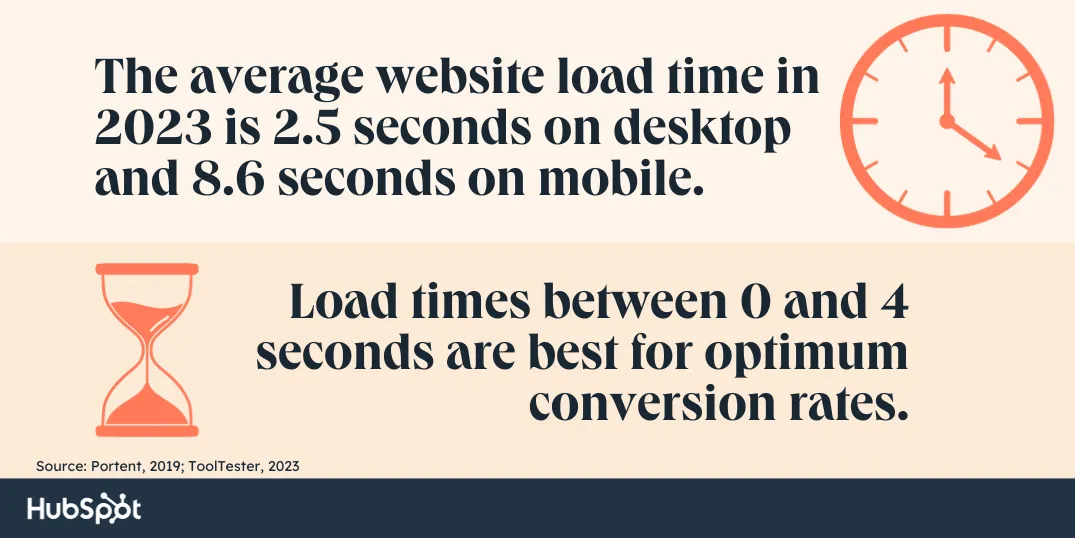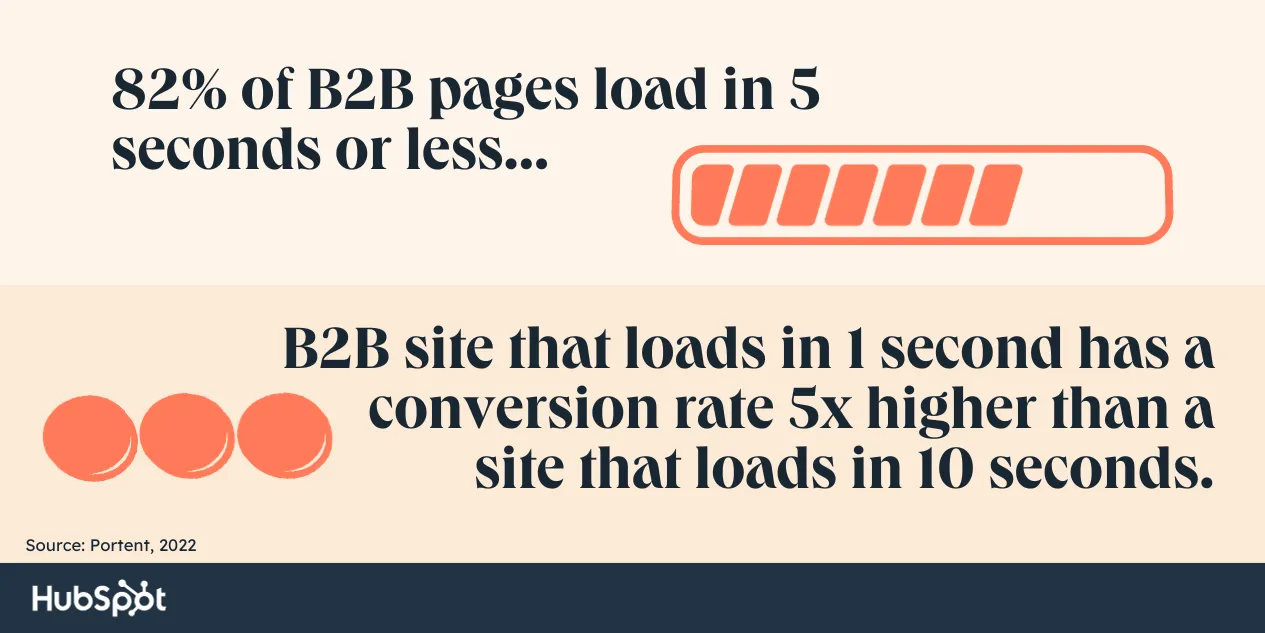Page load time is a critical metric that influences your entire site’s performance.
Even a few milliseconds can significantly impact the user experience (UX), conversion rates, and, ultimately, revenue that your site drives.
In this post, you’ll learn why your page load speed is important, how it affects your business, and some quick and easy tips to improve your performance.
Table of Contents
- What is website load time?
- Factors That Influence Page Load Time
- What is the average page load time?
- What is a good page load time?
- 11 Page Load Time Statistics
What is website load time?
Website load time — or page load time — refers to how long it takes for a website, or web page, to fully load and appear ‘on-screen’ when a user requests to visit that site.
Or, simply put, it is how quickly the content of a web page is displayed when a user clicks on the site.
Factors That Influence Website Load Time
Website or page speed depends on a wide range of factors.
“Internal” factors such as page elements, file sizes, code efficiency, plugins/widgets, etc can all impact page speed.
Similarly, “external” factors, such as server/host response times, network connections, etc., can significantly impact how quickly a page loads.
But even aside from these, the type of device a user accesses a site from can also determine how quickly the site loads.
According to Jillian Streit, a website strategist at Blue Frog, “Unfortunately, most mobile pages take much longer to load than their desktop counterparts, and mobile users expect pages to load much faster on their mobile devices.”
So, it is essential to carefully consider and optimize all these factors (internal and external) to ensure that your site loads quickly and efficiently.
For step-by-step instructions on how to do this, check out this guide that walks you through measuring and improving page speed and this post that shares 19 actionable website optimization strategies.
What is the average page load time?
The average website load time in 2023 is 2.5 seconds on desktop and 8.6 seconds on mobile, according to a recent report that analyzed over 4 billion web visits.
What is a good page load time?
Although the 2023 study is one of the more recent page load time studies, several older studies have found that much lower page speeds are required to be truly competitive.
For example, a study by Portent found that a load time between 0-4 seconds is best for optimum conversion rates.
For this reason, simply consider the average speed from the 2023 Website Loading Times Report mentioned above as a benchmark or reference point to measure and compare your current performance against the general average across an extensive range of sites.
Case in point, the study also found that only 34% of the top 100 websites (which formed a significant basis of the analyses in the study) passed their Core Web Vitals.
11 Page Load Time Statistics
Here are 11 statistics that will give you a better understanding of how your website load time could impact your site’s performance, specifically conversion rates.
Let’s get started.
- The average page load speed of B2B sites hasn’t improved over the last four years, according to a 2022 study by Portent.
- That said, 82% of B2B pages load in 5 seconds or less, meaning most sites are well within industry benchmarks.
- However, simply being within the industry benchmarks might not be enough. The Portent study also found a significant correlation between load speeds and conversions. According to the findings of that study, a B2B site that loads in 1 second has a conversion rate 3x higher than a site that loads in 5 seconds.
- And this impact becomes even more pronounced when the difference is further exaggerated. The study found that a B2B site that loads in 1 second has a conversion rate 5x higher than a site that loads in 10 seconds.
- But even more interesting is that B2C eCommerce might potentially be even more unforgiving regarding website load times. In 2019, 81% of B2C ecommerce sites loaded in less than 5 seconds — similar to the number of B2B sites today. However, in 2023, that number has jumped up to 86%.
- Interestingly, the performance difference for sites that load within this 5-second bracket is similar to that observed in B2B sites. An ecommerce site that loads within a second converts 2.5x more visitors than a site that loads in 5 seconds.
- But what exactly do these “improvements” look like in the real world? Vodafone recently conducted an A/B test to measure the impact of optimized Web Vitals. The results showed that a 31% improvement in LCP (which measures the loading performance of a page) led to a 15% improvement in their lead-to-visit rate, an 11% improvement in their cart-to-visit rate, and 8% more sales.
- So, how can you improve your page load times and potentially generate similar results? Well, a quick and easy win is simply optimizing your website for mobile devices. Although mobile currently accounts for more than half of the web traffic worldwide, several studies have found that mobile page load speeds are still significantly worse, on average, than desktop.
- A 2023 report found that web pages load 70.9% slower on mobile devices than on desktops. Interestingly, this study also found that mobile site performance was significantly worse across every website-building platform analyzed.
- And, on website builders, another easy but significant page speed boost could be found by changing your current provider. One study analyzed 400 websites built by the top 12 website builders. This research found an almost 2-second difference in average page load times between the top and worst-performing platforms.
- And keep in mind that these numbers were for desktop sites. According to this report, load speeds for mobile pages dropped drastically to an average of 6.40 seconds for even the best performer, Godaddy, while the worst performer had an average load speed of 15.26 seconds.
- Finally, as you begin to optimize your website, you should initially direct your focus to pages that attract high-intent traffic. The Portent Page Speed Study report also found that faster speeds on checkout pages, login pages, etc, made the most impact.
Other than these, several strategies can help you significantly improve your page load speeds. So, make sure to check out the guides recommended in the previous sections of this post.
Page Load Time Takeaways for Marketers
Optimizing your page load speed is integral to boosting conversion rates and sales revenue.
While a few extra seconds may not seem like a big deal, statistics show that as each second passes, the potential to lose out on prospective customers increases.
If you’re concerned your website’s page load speed could be hindering your company’s growth, there are a few solutions to decrease the time it takes for your website to load.
Online tools like Pingdom Website Speed Test, GTmetrix, and Google PageSpeed Insights allow you to time and test your website’s page speed. You can also cache your website or enable browser caching to speed up your page load time.
Ensuring your load time is as efficient as possible doesn’t necessarily take a long time or significant effort, but it requires some thought.
So, start thinking about optimizing your web page speed — and you’ll see an improvement in your UX, conversions, time-on-page, and revenue in no time.
Editor’s note: This post was originally published in March 2017 and has been updated for comprehensiveness.
![]()




